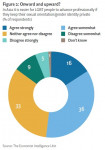Europe dominates cost of living ranking, says Economist Intelligence Unit
Of the ten most expensive cities surveyed, only Tokyo and Osaka hail from outside Europe. Western European cities make up the priciest places in the survey. Moscow (Russia·26th) is now more expensive than New York (US·28th), the most expensive destination outside Europe and Asia.
Latin America presents the best value for money overall, accounting for a quarter of the cheapest 30 cities. Guatemala City (Guatemala·63rd) has overtaken Mexico City (Mexico·68th) as the region's most expensive.
While Asian hubs and Australasian cities remain relatively costly, other cities in the region make up most of the world's cheapest destinations. Hubs like Singapore (14th), Seoul (South Korea·11th) and Bangkok (Thailand·92nd) all saw cost of living rises. Jakarta in Indonesia saw its relative cost of living jump 12 percentage points and 27 places in the ranking to 73rd.
Only two cities from Africa and the Middle East feature in the 50 most expensive destinations: Abidjan (Cote d'Ivoire·44th) and Tel Aviv (Israel·47th). The South African cities of Johannesburg and Pretoria fell furthest due to a weak rand. Although it remains in the headlines for the wrong reasons, Tehran, in Iran, presents the best value for money in the world.
As observers see London challenging New York as the world's financial centre, the city is proving itself in other ways by overtaking Tokyo in cost of living terms. London (UK·4th), Copenhagen (Denmark·3rd) and Paris (France·2nd) have all overtaken Tokyo in the last 12 months to join Oslo (Norway·1st) as the world's most expensive destinations.
Overall European cities have seen stable price inflation, although a weak Icelandic krona saw Reykjavik (Iceland·6th=) fall by 17% relative to New York. Despite this it remains relatively costly. Zurich (Switzerland·6th=), Frankfurt (Germany·9th=) and Helsinki (Finland·9th=) make up the top 10.
Better value for money in the eurozone can be found in Athens (Greece·55th) and Lisbon (Portugal·59th). Outside the European Union (EU) Moscow is the costliest destination, and is now more expensive than New York. Former Soviet Bloc countries have not matched Russian prices. Almaty (Kazakhstan·111th=), and Tashkent (Uzbekistan·120th) join Sofia of EU entrant Bulgaria (111th=), as the cheapest in the region.
Canada set to out-price the US?
If the dollar stays weak, Canadian cities could become the most expensive in North America as Vancouver (34th) and Montréal (36th=) continue to close the price gap on New York. Vancouver is now only four percentage points cheaper than New York and more expensive than any other city in North America. Montreal has the same cost of living as Chicago (36th=), the second costliest in the US.
Atlanta (84th) is the cheapest North American city. It is nearly 50% cheaper than Oslo and presents better value for money than Casablanca (Morocco) and Sao Paulo (Brazil), both of which occupy joint 79th place.
Emerging Asian hubs rise as Japan declines
Low inflation and a weak yen driven by low interest rates have caused the cost of living in Japan to fall rapidly on the global stage. Although Tokyo and Osaka remain the most expensive centres in Asia in 5th and 6th place respectively, both cities saw the cost of living against New York fall by 12 percentage points.
Conversely, emerging hubs are seeing the cost of living catch up with more developed countries. Jakarta (Indonesia·73rd), Kuala Lumpur (Malaysia·88th) Bangkok (Thailand·92nd) and Manila (Philippines·131st) all saw jumps in the cost of living, partly driven by economic growth.
Growing interest in the region, especially China, has also led to the inclusion of four new destinations in the ranking. Nouméa (New Caledonia·20th), Suzhou (China·85th), Qingdao (China·100th) and Kathmandu (Nepal·126th) have all been added to the global ranking.
Despite a rise in the relative cost of living, Manila is still the cheapest city in the region and the second cheapest in the global ranking. It has a long way to rise before it reaches the cost of living of Tokyo, which is almost three times as pricey.
Latin America offers value for money
Latin America has the cheapest average cost of living. Average prices are less than two thirds the cost of living in New York and none of the cities in the region features in the 50 most expensive destinations. Guatemala City (Guatemala·63rd) is the most expensive location in Latin America, having overtaken Mexico City (Mexico·68th) in the last 12 months.
Mexico City and Panama City (Panama·109th) have both seen the relative cost of living fall significantly in the last 12 months as cities around them become pricier and currencies have remained weak.
Paraguay and Brazil were the only countries in the region to experience a rise in the relative cost of living. Rio de Janeiro and Sao Paolo (joint 79th) both rose eight places thanks to a cost of living rise of four percentage points. Asuncion in Paraguay (124th), however, remains the cheapest city in the region despite seeing its relative cost of living rise by six percentage points.
Currency pegging masks local change in Middle East
In relative terms only a handful of cities in the Middle East and Africa experienced rises in the cost of living. However, pegging to the dollar in the Middle East and the exclusion of accommodation costs from the Worldwide Cost of Living index has disguised some large increases in local prices.
Accommodation rental and house price inflation has been strong in the Gulf States, with the influx of foreign workers also fuelling price rises, but this has not impacted on relative cost of living due to the weak dollar to which many currencies are pegged. Price controls have also lessened the impact of real estate inflation.
Only five cities in the Middle East and Africa saw the cost of living increase compared to destinations around them. Apart from Tel Aviv (Israel·47th), most of these were in Africa.
Lagos (Nigeria·59th), Lusaka (Zambia·73rd), Casablanca (Morocco·79th) and Nairobi (Kenya·88th) all saw a rise in the relative cost of living. Of these only Lusaka saw spectacular growth as stable currency movement and high inflation increased the cost of living by nine percentage points and 18 places.
Africa was also host to the largest drops in relative living costs thanks to the weak rand in South Africa. The cost of living in Johannesburg and Pretoria fell 10 percentage points leading to a ranking drop of 23 places each.
웹사이트: http://www.eiu.com
연락처
Edgar Fernandez
Marketing Manager, Asia-Pacific
(852) 2585 3826 이메일 보내기
Fax: (852) 2802 7007
이 보도자료는 Economist Intelligence Unit가(이) 작성해 뉴스와이어 서비스를 통해 배포한 뉴스입니다. 뉴스와이어는 편집 가이드라인을 준수합니다.




